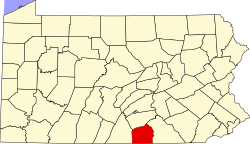Beechersville, Pennsylvania | |
|---|---|
Unincorporated community | |
| Coordinates: 39°55′02″N77°17′22″W / 39.91722°N 77.28944°W | |
| Country | United States |
| State | Pennsylvania |
| County | Adams |
| Township | Butler |
| Elevation | 640 ft (200 m) |
| Time zone | UTC-5 (Eastern (EST)) |
| • Summer (DST) | UTC-4 (EDT) |
| Area code | 717 |
| GNIS feature ID | 1169115 [1] |
Beechersville is an unincorporated community in Adams County, Pennsylvania, United States. It is located off Cherry Street where Gettysburg Street becomes Mummasburg Road, adjacent to the borough of Arendtsville.

